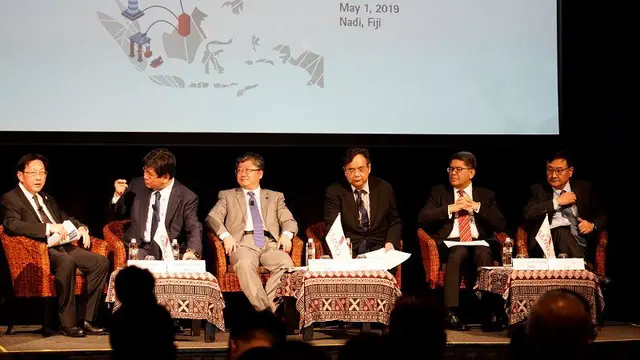By APD writer Melo M. Acuña
**MANILA, May 1 (APD) ** – ASEAN + 3 economies will have to focus on building capacity and connectivity to keep with the Fourth Industrial Revolution “in order to sustain growth in the new economy.”
This was how ASEAN + 3 Macroeconomic Research Office looks at the current situation in their seminar on “Building Connectivity and Capacity for the New Economic In East Asia” which was held earlier today in Nadi, Fiji.
In a statement released today, AMRO said their key findings in the thematic study in the ASEAN + 3 Regional Economic Outlook (AREO) 2019 was presented at the seminar to set the context for discussion.
The speakers and participants, which include high-level policymakers and senior officials of international organizations, expressed their insights and perspectives on how the region could prepare itself for the new economy and sustain robust growth and continue to accept and benefit from globalization, at this time when protectionist tendencies in the trade and technology space continue to increase.
“ASEAN+3 economies have come a long way since the 1997 Asian financial crisis. They have collectively transformed from being a crisis-shaken region in the late 1990s to one which stood resilient against the Global Financial Crisis in the late 2000s, and which is now positioning itself for many more years of rapid growth. For the next phase of economic development, the region needs to redouble its efforts to enhance capacity and cross-border connectivity in order to successfully transition to the new economy,” said AMRO Director Dr. Junhong Chang in her opening remarks.
AMRO Director Dr. Junhong Chang underscored the need for ASEAN+3 economies to build capacity and connectivity to successfully transition to the New Economy. /AMRO Photo
Meanwhile, AMRO Chief Economist Dr. Hoe Ee Khor said while the move up the technological frontier has been and will continue to be, uneven, the transformation to services is inevitable. He added it will require a review of what capacity means, and what connectivity is required in the new economy.
He added globally, manufacturing and services will be transformed by the Fourth Industrial Revolution which will require higher levels of technology, expertise and connectivity to deliver customized goods, services, and experience to an increasingly large and affluent middle class.
The panelists discussed three key drivers that will shape capacity and connectivity priorities in the region from the short to medium term. This include the Fourth Industrial Revolution and the new economy, involving rapid technological advancement and a much bigger role for the services sector, maturing populations, and a rapidly-growing middle class driving demand for goods and services as well as the deepening regional integration brought about by market forces and rising protectionist tendencies elsewhere.
The panelists said developing economies in the region continue to deal with three key challenges including funding, foreign exchange and factor gaps.
To address the funding and foreign exchange gaps, the region should continue to leverage on its savings and investments and strengthen regional financial safety net to keep financial stability and economic resilience.
Over the past years, ASEAN+3 developing economies continue to benefit from growing intra-regional investments. The region has ample foreign reservices and a further strengthening of the regional financial safety net, centered on the Chiang Mai Initiative Multilateralisation, will continue to provide a strong anchor for the region to continue pursuing rapid and high-quality growth.
As to the factors fap, the region should continue developing professional expertise, technology and institutions and “leverage” on various initiatives to build regional capacity and connectivity, such as the Belt and Road Initiative, the Master Plan for ASEAN Connectivity, as well as the ASEAN Framework Agreement on Services.
AMRO+3 Macroeconomic Research Office (AMRO) is an international organization established to contribute towards securing macroeconomic and financial stability of the ASEAN+3 region which includes the ten members of the ASEAN and China, Hong Kong China, Japan and Korea. It conducts macroeconomic surveillance, support the implementation of the regional financial agreement, the Chiang Mai Initiative Multilateralisation (CMIM) as well as provide technical assistance to its members.
(Top image: Panelists discuss dirvers, gaps and policy implications on building capac ity and connectivity for the new economy. The panelists are AMRO chief economist How Ee Khor (from left to right), Chikahisa Sumi, Director, Office of Asia Pacific, International Monetary Fund, Yasuyuki Sawada, Chief Economist, Asian Development Bank, Francisco G. Dakila, Jr. Assistant Governor of the Monetary Policy Sub-Sector, Bangko Sentral ng Pilipinas, Marzunisham bin Omar, Assistant Governor, Bank Nagara Malaysia, Dong-ik Lee, Vice President and Director General of the Investment Operations Department, Asian Infrastructure Investment Bank. /AMRO Photo)
(ASIA PACIFIC DAILY)
 简体中文
简体中文

